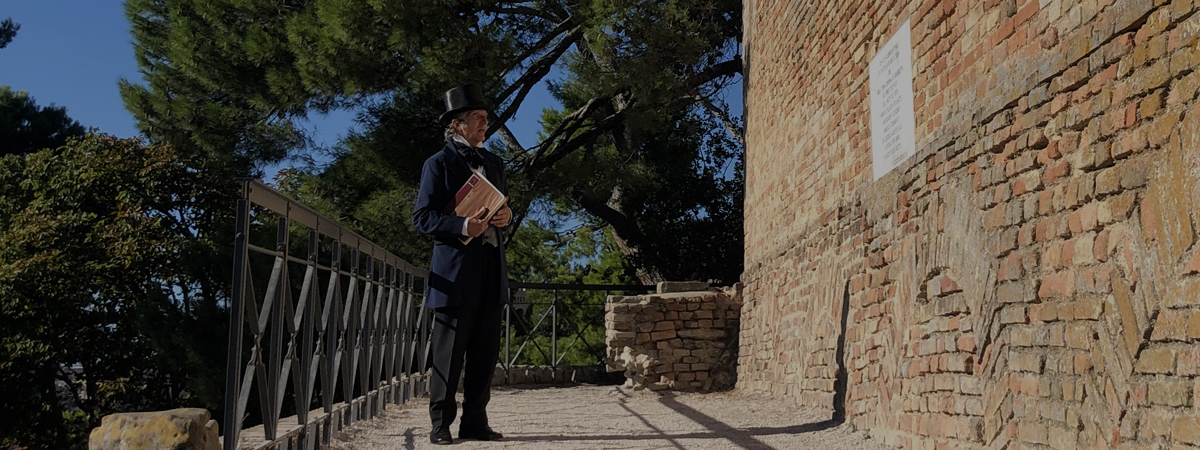Lorenzo Lotto in Recanati
Rrecanatis' works
THE ANNUNCIATION
CARTA D’IDENTITÀ
Annunciation
1533-1535
Oil painting on canvas.
Signed on the kneeler of the Virgin L. Lotus
Inv. 1562
Provenance: Recanati, Oratory of S. Giorgio, altar of the Merchants’ Confraternity (until the 18th century); Recanati, church of S. Maria sopra Mercanti, main altar; Civic art gallery (since 1953)
Restorations: 1953
The painting was commissioned in 1533 when the Confraternity of Santa Maria dei Mercanti was transferred to the Oratory of S. Giorgio. It is recorded there for the first time by local sources in 1601 as an altarpiece of the Confraternity.
The work is one of Lorenzo Lotto’s most original works, for its unusual approach to the theme of the Annunciation of the Virgin, remarkably familiar and widespread in the collective imagination and throughout Western art. The scene takes place following the story from the Gospel of Luke (1.29). The Virgin is caught by surprise by the arrival of the archangel Gabriel in a moment of daily and domestic life. In fact, she feels shocked by the words spoken by the angel, who announces her imminent becoming the mother of Jesus, the son of God.
THE WORK
CHRONOLOGICAL FRAMEWORK
1533
The Confraternity of S. Maria dei Mercanti of Recanati, one of the oldest and most prestigious in the city, responsible for monitoring the honesty of the merchants, moves to the new headquarters of the Oratory of S. Giorgio, in the central district of Sant’Angelo. The commissioning of the work to Lotto refers to this occasion and date.
1533
28 January – In Venice Lorenzo Lotto gives the notary Daniele Giordani a codicil to his will of 25 March 1531, written a couple of weeks earlier. The artist declared; he was about to move to the Marche region.
20 October – During the Recanati Fair Lorenzo Lotto is in the city, according to Giuliano di Francesco Polini, firstborn of Francesco or Cecco Polini who co-financed the Polyptych of San Domenico in 1506. Giuliano was a goldsmith like his father; he inherits his workshop, together with his brothers Aurelio and Girolamo, and continues the business, which consists in the production and trade of rosary crowns and devotional objects also sold in Loreto.
1534
13 April – The artist is in Ancona.
24 October – Lorenzo Lotto is a resident of Ancona where he appoints Giovanni del Coro as his attorney, authorized to collect money in his name and sell his works.
1535
In 1535 Lotto signed and dated the Madonna in Glory with Saints Andrew and Jerome for the church of Sant’Agostino in Fermo (today in a private collection). In the same year, the artist is in Jesi.
1601
Giovan Francesco Angelita, historian of the city and collector of Lotto’s works, declares that the Annunciation in the Oratory of S. Giorgio at the altar of the Confraternity of S. Maria dei Mercanti, is beautiful.
1834
Amico Ricci in the Historical Memoirs of the Arts and Artists of the Marca of Ancona reports the works of Recanati by Lorenzo Lotto and confirms: There is also a small panel by Lotto in Recanati with the Annunziala in the Oratorio de Mercanti, which it was for a brief time in the Cathedral.
1893
The Annunciation, still in the Oratory, had two exceptional visitors in Bernhard Berenson and his future wife Mary Whithall Smith Costelloe, on tour between Lombardy and Marche to discover the artist’s works. The trip to Recanati dates to May 1893 and is documented in Costelloe’s travel notebooks and then in Berenson’s monograph on Lorenzo Lotto (first edition in 1895).
1953
The exhibition on Lorenzo Lotto curated by Pietro Zampetti displayed the work at the Doge’s Palace in Venice (14 June – 18 October 1953). It was used as the cover image of the catalogue, then the work was moved to the Recanati art gallery and remained the property of the IRCER Foundation of the city, an organization that still exists.
1998
The Annunciation becomes part of the collections of the civic museums of Villa Colloredo Mels.
• Interpretation of the work
Source: Gospel of Luke, I, 28-29.
28- Entering her, he said: “Hail, full of grace, the Lord is with you.”
29- Hearing the words she was troubled and wondered what meaning such a greeting could have had.
The interior where the scene takes place, barely illuminated by a soft golden light that comes from a small window above, features a canopy bed, in dim light on the left, recognizable as thalamus Virginis, symbol of the union of the Madonna with God. Objects in common use placed above the shelf, they compose still life and are a testimony to Lotto’s knowledge of Flemish painting. You can see books, candelabra, an inkwell and, hanging below, a nightcap and a white towel, both belonging to Mary. A little further down, on a light wooden stool, an hourglass is placed, slightly covered by a cloth, the purpose of which has been recognized as that of measuring the duration of Christianity, starting from the Incarnation. A large opening with a round arch leads to a loggia with a wooden ceiling and an elegant marble balustrade that overlooks a garden of rare beauty and brightness where you can see both tall trees and a rose garden.
The garden alludes to the Marian hortus conclusus, symbol of her virginal purity.
A clear, sunny and spring light enters the room and seems to rest on every area and object in such a natural way as to make it concretely credible that the event narrated in the Gospel is about to unfold before our eyes. In fact, the sacred episode begins from the garden. God the Father, high on the clouds, seems to want to enter the scene and strengthen the divine intervention towards Mary with his hands joined. The archangel Gabriel holds the lily (symbol of Mary’s purity) in his hand and addresses her directly; he kneels on the ground in front of the Mystery of the Incarnation, and with his real presence, generates a shadow on the floor. He is a powerful figure, with blond hair still blowing in the wind and a fluttering robe.
The Virgin who is reading the prayer book placed on the lectern, wears a red dress covered by a slightly lighter tunic, with golden fringes and decorations and a blue veil tied around her breasts down to her feet. She is caught in the moment of conturbatio, her amazement caused by the arrival of the angel and his words: we observe the emotion that can be seen in her face and the posture of her hands, which betray fear combined with surprise, in the awareness of making part of a greater unfathomable divine mystery. The amazement is so great that the Virgin assumes, turning towards the viewer, an unusual but fully realistic pose. The young woman’s dismay is underlined by the presence of the cat, depicted with its back arched as it was frightened by the arrival of the Archangel. A symbol of evil thrown out by the imminent Incarnation, gives the subject an even more authentic streak.
The skillful use of colors, the subtle dim light of the area of the room near the bed, the shadows in the scene – from that of the marble balustrade on the loggia to those of the angel, the cat and the Virgin Mary herself – restore the atmosphere silent of a timeless spring day, where the sacred joins the human.
• The “Annunciation”, A Subject Loved By Lorenzo Lotto
Lorenzo Lotto had already experimented the theme of the Annunciation in the Ponteranica Polyptych in the Bergamo area (1522), in the cycle of frescoes with Stories of the Virgin in the church of S. Michele al Pozzo Bianco in Bergamo(1525) and in the two panels with the Announcing Angel (1) and the Virgin of Jesi (1526, Civic Art Gallery of Palazzo Pianetti).
The Annunciation of Recanati presents stylistic affinities with contemporary works by Lorenzo Lotto from the 1930s, including the Madonna with Child and three angels already in the town hall of Osimo and stolen in 1911 and the Saint Christopher between Saints Rocco and Sebastiano of Loreto (2); in particular, the face of the archangel Gabriel follows that of Saint Sebastian, a section of the lost polyptych of Castelplanio (3 – 1531, Gemaldegalerie of Berlin) and of the aforementioned painting of Loreto.
• Iconographic precedents
The scene takes place in a domestic environment that reflects Lotto’s knowledge of similar subjects of Flemish painting where the sacred scenes context is within family homes and therefore present objects and furniture typical of the time. Critics have identified the amazing Annunciation by the Flemish Dieric Bouts (circa 1450, Getty Museum, Malibu), the painting which, already in a private Venetian collection in the 15th century, may have inspired Lotto for the angel approaching the Virgin Mary behind his back. Titian’s Annunciation in the Treviso Cathedral (Malchiostro Chapel, 1520) may also have inspired the scheme of the Annunciation in Recanati. It was commissioned by Broccardo Malchiostro, secretary of the humanist bishop Bernardo de Rossi, portrayed by Lotto in 1503 (the painting is preserved in the National Museum of Capodimonte in Naples), both characters frequented by the artist at the beginning of his career in Treviso.
In the Marche, two illustrious previous works inspired Lorenzo Lotto for Annunciation in Recanati:
• The Annunciation by Olivuccio di Ceccarello already in the triumphal arch of the church of S. Agostino in Recanati and dating back to the beginning of the century. XV, where the posture of the Virgin’s hands recalls that of Lotto’s Virgin (1).
• The panel of the marble covering of the Holy House of Loreto designed by Donato Bramante (c.1506-1509), sculpted by Andrea Sansovino in 1521 which depicts the Virgin suddenly seized by the angel in front of a canopy bed, domestic objects above a shelf, God the Father and a cat that turns towards the viewer.
DETAILS
• The characters
• The collected room: the furniture, the objects, the cat
• The bright garden
TWENTIETH CENTURY READINGS
• Carlo Emilio Gadda and the Annunciation of Recanati
In Carlo Emilio Gadda’s famous book Quer pasticciaccio brutto de di Via Merulana (1946/1947) there is a precise reference to the Annunciation by Lorenzo Lotto of Recanati. In fact, in a passage from the seventh chapter the author meticulously describes the expression on the face of a character who suddenly appears to Doctor Francesco Ingravallo, alias Don Ciccio:
“The silent and unexpected appearance of him from the stairway: a young man of singular beauty, certainly, blond like an archangel, but without a sword; returning from throwing a spear into the Abyss. It had a significant impact on the Abyss. He had in his face, a firm and pale face with little cheekbones, in his clear and certainly blue gaze that sort of arrogant, almost hysterical volition, which a painter in the Marche had studied (and pleased) to perfect the notes of natural physiognomy of celestial birds, who were in charge of carrying messages. This willing become: everything must go his way, which before being his way is mine, since I am an archangel”.

